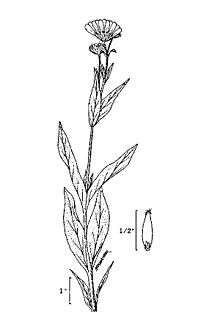Arnica chamissonis
Arnica chamissonis, the Chamisso arnica,[2] is a North American species of plants in the sunflower family. It is very similar to Arnica montana. Arnica chamissonis is native to North America and naturalized in parts of Europe while A. montana is indigenous to Europe.[3][4]
| Arnica chamissonis | |
|---|---|
 | |
| Scientific classification | |
| Kingdom: | |
| (unranked): | |
| (unranked): | |
| (unranked): | |
| Order: | |
| Family: | |
| Genus: | |
| Species: | A. chamissonis |
| Binomial name | |
| Arnica chamissonis | |
| Synonyms[1] | |
|
Synonymy
| |
Distribution and habitat
Arnica chamissonis is native to western North America, including Alaska, and most of Canada including Yukon and Northwest Territories.[5][6] Arnica chamissonis is perennial. It has a temperature minimum of −33 °F (−36 °C).[5] They are adapted to both coarse and medium textured soils with a pH between 6.0–7.2.[5] Since this plant uses a lot of moisture, it has a precipitation requirement of between 14–24 inches (36–61 cm).[5] It generally prefers moist meadows and conifer forests and often grows in montane to subalpine zones, 0–3,500 metres (0–11,483 ft).[7] Seeds are easily available and the plant can be grown in a home garden. It prefers full sun exposure and an average soil temperature of 65–75 °F (18–24 °C).[8]
Morphology

Arnica chamissonis has yellow flowers with green medium textured foliage.[5] The leaves of the Arnica chamissonis are grouped in 4–10 pairs.[7] It produces brown seeds and has an active growth period of the spring and summer. It has rhizomatous growth and grows at a moderate rate.[5] Rhizomatous plants have an underground stem with small fiber-like adventitious roots. A. chamissonis has a mature height of roughly 2.5 feet (76 cm).
Reproduction and growth
Arnica chamissonis has an active bloom period throughout the summer.[5] There are approximately 400,000 seeds per pound. These individuals have a medium seedling vigor and a moderate vegetative spread rate.[5] Seedling vigor refers to "the expected seedling survival percentage of the plant compared to other species with the same growth habit." A vegetative spread rate refers to how quickly a plant can spread through a given area. In general, A. chamissonis can be grown in a container, by using seeds or sprigs.[5]
Both A. montana and A. chamissonis contain the toxin helenalin.
The species is named for German poet and botanist Adelbert von Chamisso, 1781–1838.[9][10]
References
- The Plant List Arnica chamissonis Less.
- Calflora taxon report, University of California, Arnica chamissonis Less. Chamisso arnica
- "Invasive Species Compendium, 2011 Edition". CAB International, Wallingford, UK, 2011.
- Altervista Flora Italiana, Arnica montana L. includes photos and European distribution map
- "Arnica chamissonis". Natural Resources Conservation Service PLANTS Database. USDA.
- Biota of North America Program, 2014 state-level distribution map
- Flora of North America Editorial Committee (ed.). "Arnica chamissonis". Flora of North America North of Mexico (FNA). New York and Oxford – via eFloras.org, Missouri Botanical Garden, St. Louis, MO & Harvard University Herbaria, Cambridge, MA.
- "Restoration Seeds". Archived from the original on 2013-03-24.
- Brummitt, R. K.; C. E. Powell (1992). Authors of Plant Names. Royal Botanic Gardens, Kew. ISBN 978-1-84246-085-6.
- Lessing, Christian Friedrich 1831. Linnaea 6(2): 238–239 in Latin
External links
- Arnica chamissonis in the CalPhotos Photo Database, University of California, Berkeley